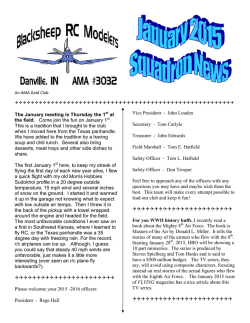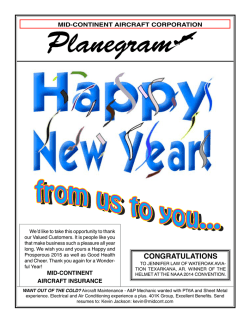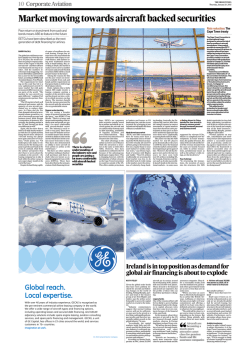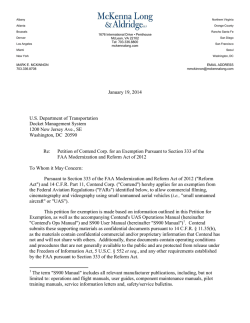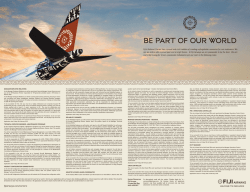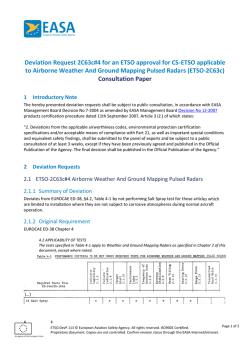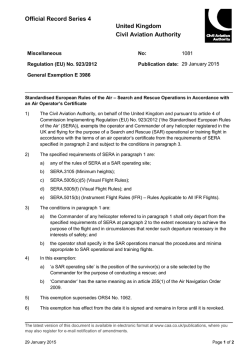
Voler_Inc_-_Exemption_Rulemaking
December 22, 2014 U.S. Department of Transportation Docket Management System 1200 New Jersey Ave., SE Washington DC 20590 Dear Sir or Madam: Attached please find Voler Inc.’s (“Voler”) request for an exemption from the listed Federal Aviation Regulations to allow commercial operation of its Small Unmanned Aircraft Systems (“sUASs”) for aerial imaging for safety and monitoring of secured and controlled environment construction sites. Thank you for your time and consideration, and please let me know if you have any questions. Sincerely, Marc Asselin Voler Inc. Founder and President December 22, 2014 U.S. Department of Transportation Docket Management System 1200 New Jersey Ave., SE Washington DC 20590 Re: Exemption Request Section 333 of the FAA Reform Act and Part 11 of the Federal Aviation Regulations from 14 C.F.R. 45.23(b); 14 CFR Part 21; 14 CFR 61.113(a) & (b); 91.7(a); 91.9(b) (2); 91.103(b); 91.109; 91.119; 91.121; 91.151(a) & (b); 91.405 (a); 91.407(a) (1); 91.409 (a) (2); 91.417 (a) & (b). Dear Sir or Madam: Pursuant to Section 333 of the FAA Modernization and Reform Act of 2012 (the Reform Act) and 14 C.F.R Part 11, Voler Inc. (“Voler”), an aerial imaging firm, hereby applies for an exemption from the listed Federal Aviation Regulations (“FARs”) to allow commercial operation of its Small Unmanned Aircraft Systems (“sUASs”) for aerial imaging for safety and monitoring of secured and controlled environment construction sites, so long as such operations are conducted within and under the conditions outlined herein or as may be established by the FAA as required by Section 333. As detailed in this document the requested exemption would permit the operation of sUAS under controlled conditions in airspace that is 1) limited 2) predetermined 3) controlled as to access and 4) would provide safety enhancements to the already best practices safety protocols followed by Voler. Approval of this exemption would thereby enhance safety and fulfill the Secretary of Transportation’s (the FAA Administrator’s) responsibilities to “..establish requirements for the safe operation of such aircraft systems in the national airspace system.” Section 333 (c) of the Reform Act. The name and address of the applicant is: Voler Inc. Marc Asselin PH: 561-676-3917 Email: [email protected] Address: 3825 Majestic Palm Way, Delray Beach Florida 33445 Regulations from which the exemption is requested: 14 C.F.R. Part 21 14 C.F.R. 45.23(b) 14 C.F.R. 61.113 (a) & (b) 14 C.F.R. 91.7 (a) 14 C.F.R. 91.9 (b) (2) 14 C.F.R 91.103 14 C.F.R. 91.109 14 C.F.R. 91.119 14 C.F.R. 91.121 14 C.F.R. 91.151 (a) 14 C.F.R. 203 (a) & (b) 14 C.F.R. 91.405 (a) 14 C.F.R. 407 (a) (1) 14 C.F.R. 409 (a) (2) 14 C.F.R. 417 (a) & (b) 1. STATUTORY AUTHORITY FOR EXEMPTIONS The Federal Aviation Act expressly grants the FAA authority to issue exemptions. This statutory authority includes exempting civil aircraft, as the term is defined under 40101 of the Act, including sUASs, from the requirement that all civil aircraft must have a current airworthiness certificate. The Administrator may grant an exemption from a requirement of a regulation prescribed under subsection (a) or (b) of this section or any sections 44702-44716 of this title if the Administrator finds the exemption ion the public interest. 49 U.S.C. 44701(f) See also 49 USC 44711(a); 49 USC 44704; 14 CFR 91.203(a)(1). Section 333(b) of the Reform Act assists the Secretary in determining whether sUASs may operate in the National Airspace System (NAS) without creating a hazard to the user, the public, or a threat to national security. In making this determination, the Secretary must consider: The sUAS’s size, weight, speed, and operational capability; Whether the sUAS operates within the visual line of sight of the operator Whether the sUAS operated outside of highly populated areas and away from close proximity to airports. Reform Act 333(a). If the Secretary determines that a sUAS “may operate safely in the national airspace system, the Secretary shall establish requirements for the safe operation of such aircraft in the national airspace system.” Id. 333(c). Voler’s sUASs are multirotator vehicles, weighing 10 or fewer lbs. including payload. He operate under normal conditions at a speed of no more than 50 knots and have the capability to hover, and move in the vertical and horizontal plane simultaneously. The sUASs will operate only in the pilot’s visual line of sight at all times. Such operations will insure that the sUASs will “not create a hazard to users of the national airspace system or the public. “Reform Act Section 333 (b). Given the small size of the sUASs involved and the restricted environment within which they will operate, our application falls squarely within the zone of safety (an equivalent level of safety) in which Congress envisioned that the FAA must, by exemption, allow commercial operations of sUASs to commence immediately. Also due to the small size of the sUASs and the low altitudes and restricted areas in which our sUASs will operate, approval of the application presents no national security issue. Given the clear direction in Section 333 of the Reform Act, the authority contained in the Federal Aviation Act, as amended; the strong equivalent level of safety surrounding the proposed operations, and the significant public benefit, including enhanced safety, the grant of the requested exemptions is in the public interest. Accordingly, Voler respectfully requests that the FAA grant the requested exemption without delay. II. PUBLIC INTEREST This exemption application is expressly submitted to fulfill Congress’ goal in passing Section 333(a) through (c) of the Reform Act. This law directs the Secretary of Transportation to consider whether certain unmanned aircraft systems may operate safely in the NAS before completion of the rulemaking required under Section 332 of the Reform Act. By granting an exemption the FAA will fulfill Congress’ intent of allowing UAS to operate with significant safety precautions in low risk environments. The use of sUASs on a construction site can significantly reduce the risk to workers of falls while inspecting, surveying, or monitoring site progress. sUASs can inspect, photograph, and collect data on hard to get to areas that otherwise would require worker inspection. Falls are the leading source of workplace fatality and injury on construction sites, and reducing falls through sUAS use for site imaging could save workers lives. Additionally, sUASs could replace the use of helicopters and small aircraft to monitor sites. The sUASs we propose to fly in this application are under five pounds, and carry no combustible material on board, as opposed to the much larger conventionally powered small aircraft. Shifting to sUASs from helicopters presents a marked safety increase for workers and the public. Lastly, sUASs reduce the environmental impact by dramatically reducing the energy used for aerial imaging and data collection over a construction site. Our sUASs use rechargeable lithium ion batteries, as opposed to fossil fuels burned in operation of small aircraft that are many hundreds of times heavier. III. EQUIVALENT LEVEL OF SAFETY Voler proposes that the exemption requested herein apply to civil aircraft that have the characteristics and that operate with the limitations listed herein. These limitations provide for at least an equivalent or even higher level of safety to operations under the current regulatory structure because the proposed operations represent a safety enhancement to the already safe protocols followed on construction sites and imaging and surveying operations conducted with helicopters and other conventional aircraft. Voler will be bound by the following limitations when conducting its sUAS operations under an FAA issued exemption: 1. The sUAS will be less than 10 pounds. 2. Flights will be operated within visual line of sight of a pilot. 3. Maximum total flight time for each operational flight will be 30 minutes. The UAS calculates battery reserve in real time, and will return to it ground station with at least 20% battery power reserve should that occur prior to the 30 minute limit. 4. Flights will be operated at an altitude of 200 feet AGL, never exceeding 400 feet AGL. 5. Crew for each operation will consist of the sUAS pilot who will keep the sUAS within his visual line of sight at all times. 6. The sUAS pilot will be trained in flight, operations, and safety procedures. 7. The sUAS will only operate within a confined area. 8. A briefing will be conducted in regard to the planned sUAS operations prior to each day’s production activities. It will be mandatory that all personnel who will be performing duties within the boundaries of the safety perimeter be present for this briefing. 9. All onsite personnel will consent to the UAS flyover on site by waiver, and the operator will obtain additional verbal or written consent of all persons who will be allowed within 100 feet of the flight operation. 10. The pilot will have been trained in operation of UASs generally and received up-to-date information on the particular UAS to be operated. 11. Written and/or oral permission from the relevant property holders will be obtained. 12. All required permissions and permits will be obtained from territorial, state, county, or city jurisdiction, including local law enforcement, fire, or other appropriate governmental agencies. 13. If the sUAS loses communications or loses its GPS signal, it will have the capability to return to a pre-determined location within the Security Perimeter and land. 14. The sUAS will have the capability to abort a flight in case of unpredicted obstacles or emergencies. IV. DESCRIPTION OF SPECIFIC REGULATIONS 14 CFR Part 21, Subpart H: Airworthiness Certificates 14 C.F.R 91.203(a)(1) Subpart H, entitled Airworthiness Certificates, establishes the procedural requirements for the issuance of airworthiness certificates as required by FAR 91.203 (a)(1). Given the size and limited operating area associated with the aircraft to be utilized by Voler, an exemption from Part 21 Subpart H meets the requirements of an equivalent level of safety under Part II and Section 333 of the Reform Act. The Federal Aviation Act (49 U.S.C 44701 (f) and Section 333 of the Reform Act both authorize the FAA to exempt aircraft from the requirement for an airworthiness certificate, upon consideration of the size, weight, speed, operational capability, and proximity to airports and populated areas of the particular UAS. Our small UAS will be operated at low speed in a controlled environment, at least five miles from an airport and more than three miles from any city or densely populated area. An analysis of these criteria demonstrates that the UAS operated without an airworthiness certificate, in the restricted environment and under the conditions proposed will be at least as safe, or safer, than conventional aircraft (fixed wing or helicopter) operating with an airworthiness certificate without the restrictions and conditions proposed. The sUAS to be operated hereunder is less than 10 lbs. fully loaded, carries neither a pilot nor passenger, carries no explosive materials or flammable liquid fuels, and operates exclusively within a secured area. Like other civil aircraft, operations under this exemption will be tightly controlled and monitored by the operator, and under the requirements and in compliance with local public safety requirements, to provide security for the area of operation as is currently done on active construction sites. The FAA will have advance notice of all operations. These safety enhancements, which already apply to civil aircraft operated in connection with construction sites, provide a greater degree of safety to the public and property owners than conventional operations conducted with airworthiness certificates issued under 14 C.F.R. Part 21, Subpart H. Lastly, application of these same criteria demonstrates that there is no credible threat to national security posed by the UAS, due to its size, speed of operation, location of operation, lack of explosive materials or flammable liquid fuels, and ability to carry and external load no greater than two lbs. 14 C.F.R. 45.23(b): Marking of the Aircraft This regulation requires certain experimental, provisionally certified aircraft, or light-sport category aircraft to be marked with letters between 2 inches and 6 inches high “limited”, “restricted”, “light-sport”, “experimental”, or “provisional”, near each entrance to a cabin, cockpit, or pilot station. Even though the UAS will have no airworthiness certificate, an exemption may be needed as the UAS will have no entrance to the cabin, cockpit, or pilot station on which the word “Experimental” can be placed. Given the size of the sUAS, two-inch lettering will be impossible. The word “Experimental” will be placed on the fuselage in compliance with 45.29(f). The equivalent level of safety will be provided by having the sUAS marked on its fuselage as required by 45.29(f) where the pilot, observers and others working with the sUAS will see the identification of the UAS as “Experimental” The FAA has issued the following exemptions to this regulation. Exemptions Nos. 10700, 8738, 10167 and 10167A. 14 CFR 61.113 (a) & (b): Private pilot privileges and limitations: Pilot in command Sections 61.113 (a) & (b) limit private pilots to non-commercial operations. Because the UAS will not carry a pilot or passengers, the proposed operations can achieve the equivalent level of safety of current operations by requiring the pilot operating the aircraft to have completed a UAS flight training course of 100 hours before flying a UAS. Unlike a conventional aircraft that carries the pilot and passengers, the sUAS is remotely controlled with no living thing or cargo on board. The area of operation is controlled and restricted, and all flights are planned and coordinated in advance. The risks associated with commercial operations contemplated by Part 61 when drafted, that allowing operations of the sUAS as requested with a pilot who has met the minimum requirements exceeds the present level of safety achieved by 14 C.F.R. 61.113 (a) & (b). 14 C.F.R. 91.7 (a): Civil aircraft airworthiness The regulation requires that no person may operate a civil aircraft unless it is in airworthy condition. As there is no airworthiness certificate issued for the aircraft, should this exemption be granted, no FAA regulatory standard will exist for determining airworthiness. Given the size of the aircraft and the use of safety checklists prior to each flight, as set forth in Section B and Section G, an equivalent level of safety will be provided. 14 C.F.R. 91.9 (b)(2): Civil aircraft flight manual, marking, and placard requirements The sUAS, given its size and configuration has no ability or place to carry such a flight manual on the aircraft, not only because there is no pilot on board, but because there is no room or capacity to carry such an item on the aircraft. The equivalent level of safety will be maintained by keeping the flight manual at the ground control point where the pilot flying the sUAS will have immediate access to it. The FAA has issued the following exemptions to this regulation: Exemption Nos. 8607, 8737, 8738, 9299, 9299A, 9565, 9565B, 10167, 10167A, 10602, 32827, and 10700. 14 C.F.R. 91.103: Preflight Action This regulation requires each pilot in command to take certain actions before a flight to ensure the safety of flight. An exemption is needed from this requirement as the pilot will take separate preflight actions, including checking for weather conditions, checking flight battery requirements, checking takeoff and landing distances, and all other actions in the Preflight Checklist in the Manual. These actions will provide an equivalent level of safety. 14 C.F.R. 91.109 Flight Instruction Section 91.103 provides that no person may operate a civil aircraft (except a manned free balloon) that is being used for flight instruction unless that aircraft has fully functioning dual controls. By design, sUAS and remotely piloted aircraft do not have fully functional dual controls. Flight control is accomplished through the use of a control box that communicates with the aircraft via radio communications. The FAA has previously approved exemptions for aircraft without fully functional dual controls. See Exemption Nos. 5778K & 9862A. The equivalent level of safety provided by the fact that neither a pilot nor passengers will be carried in the aircraft, the ability to control the uUAS via radio signals from the controller, and by the size and speed of the aircraft. 14 C.F.R. 91.119: Minimum Safe Altitudes Section 91.119 establishes safe altitudes for operation of civil aircraft. Section 91.119 (d) allows helicopters to be operated at less than the minimums prescribed, provided the person operating the helicopter complies with any route or altitudes prescribed for helicopters by the FAA. This exemption is for a multirotor craft that flies similarly to a helicopter, with vertical takeoff and vertical landing, which will typically operate at altitudes of 200 AGL, so an exemption may be needed to allow such operations. The UAS will never operate at altitude higher than 400 AGL and will be in a restricted area with security perimeter, where buildings and people will not be exposed to operations without their pre-obtained consent. The equivalent level of safety will be achieved given the size, weight, speed of the UAS as well as the location where it is operated. No flight will be taken without the permission of the property owner or local officials. Because of the advance notice to the property owner and any onsite personnel, all affected individuals will be aware of the planned flight operations. Compared to flight operations with aircraft or rotorcraft weighing far more that the maximum 10 lbs. proposed herein and carrying flammable fuel, any risk associated with our operations of the sUAS will ensure separation between these small UAS operations and the operations of conventional aircraft that must comply with Section 91.119. 14 C.F.R. 91:121: Altimeter Settings This regulation requires each person operating an aircraft to maintain cruising altitude by reference to an altimeter that is set “..to the elevation of the departure airport or an appropriate altimeter setting available before departure.” As the sUAS may not have a barometric altimeter, but instead a GPS altitude read out, an exemption may be needed. An equivalent level of safety will be achieved by the operator, pursuant to the Safety Checklist, confirming the altitude of the launch site shown on the GPS altitude indication before flight. 14 C.F.R. 91.151 (a): Fuel requirements for flight in VFR conditions Section 91.151 (a) outlines fuel requirements for beginning a flight in VFR conditions. Our UAS is limited to operations in sterile and controlled environments as outlined above and has a limited range and flight time which require an exemption from 14 CFR 91.151 (a). The battery powering the sUAS provides approximately 35 minutes of powered flight. To meet the 30 minute reserve requirement in 14 CFR 91.151, sUAS flights would be limited to approximately 5 minutes in length. Given the limitations on the UAS’s proposed flight area and the location of its proposed operations within a predetermined area, a longer time frame for flight in daylight or night VFR conditions is reasonable. Voler believes that an exemption from 14 CFR 91.151 (a) falls within the scope of prior exemptions. See Exemption 10673 (allowing Lockheed Martin Corporation to operate without compliance with FAR 91.151 (a)). Operating the small UAS, in a tightly controlled area where only people and property owners or official representatives who have signed waivers will be allowed, with less than 30 minutes of reserve fuel, does not engender the type of risks that Section 91.151 (a) was intended to alleviate given the size and speed of the small UAS. Additionally, limiting sUAS flights to 10 minutes would greatly reduce the utility for which the exemption will be granted. An equivalent level of safety can be achieved by limiting flights to 30 minutes, or enough battery reserve to ensure that the sUAS lands at the ground station with at least 20% of battery power (as determined by the onboard monitoring system and the pilot), whichever happens first. This restriction would be more than adequate to return the sUAS to its planned landing zone from anywhere in its limited operating area. Similar exemptions have been granted to other operations, including Exemptions 2689F, 5745, 10673, and 10808. 14 CFR 91.203 (a) & (b): Carrying civil aircraft certification and registration. The regulation provided in part: (a) Except as provided in 91.715, no person may operate a civil aircraft unless it has within it the following: (1) An appropriate and current airworthiness certificate…. (b) No person may operate a civil aircraft unless he airworthiness certificate required by paragraph (a) of this section or a special flight authorization issued under 91.715 is displayed at the cabin or cockpit entrance so that it is legible to passengers or crew. The UAS fully loaded weighs no more than 10 lbs and is operated without an onboard pilot. Therefore there is no ability or place to carry certification and registration documents or to display them on the sUAS. An equivalent level of safety will be achieved by keeping these documents at the ground control point where the pilot flying the sUAS will have immediate access to them, to the extent they are applicable to the sUAS. The FAA has issued numerous exemptions to this regulation. A representative sample of other exceptions includes Exemption Nos. 9565, 9665, 9789, 9789A, 9797, 9797A, 9816A, and 10700. 14 CFR 91.405 (a); 407 (a)(1); 409 (a)(2); 417 (a) & (b): Maintenance inspections These regulations require that an aircraft operator or owner “shall have that aircraft inspected as prescribed in subpart E of this part and shall between required inspections, except as provided in paragraph © of this section, have discrepancies repaired as prescribed in part 43 of this chapter…,” and others shall inspect or maintain the aircraft in compliance with Part 43. Given that these sections and Part 43 apply only to aircraft with an airworthiness certificate, these sections will not apply to Voler. Maintenance will be accomplished by the operator pursuant to the flight manual and operating handbook as referenced in the Manual. An equivalent level of safety will be achieved because these small UASs are very limited in size and will carry a small payload and operate only in restricted areas for limited periods of time. If mechanical issues arise the UAS can land immediately and will be operating from no higher than 400 feet AGL. As provided in the Manual, the operator will ensure that the UAS is in working order prior to initiating flight, perform required maintenance, and keep a log of any maintenance performed. Moreover, the operator is the person most familiar with the aircraft and best suited to maintain the aircraft in an airworthy condition to provide the equivalent level of safety. ********** Sincerely, Marc Asselin Voler Inc. Founder and President
© Copyright 2025

